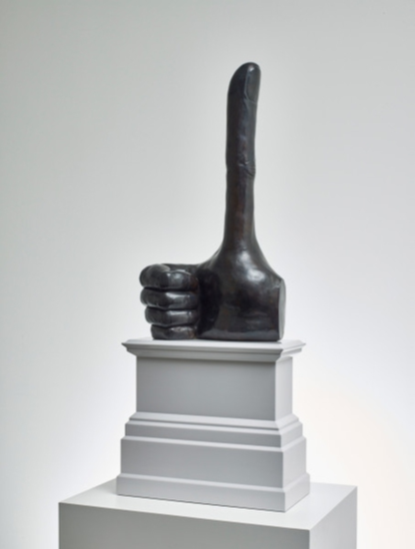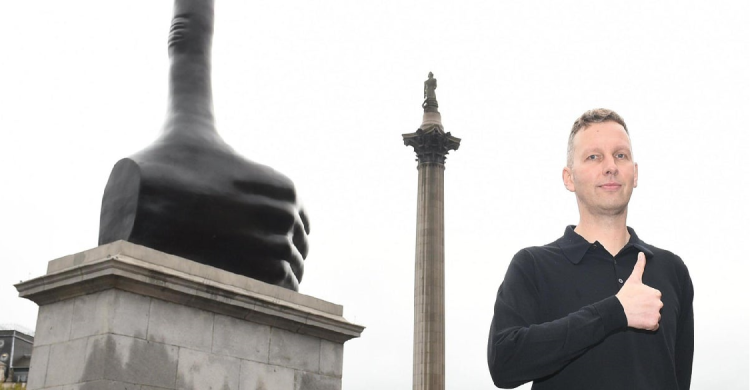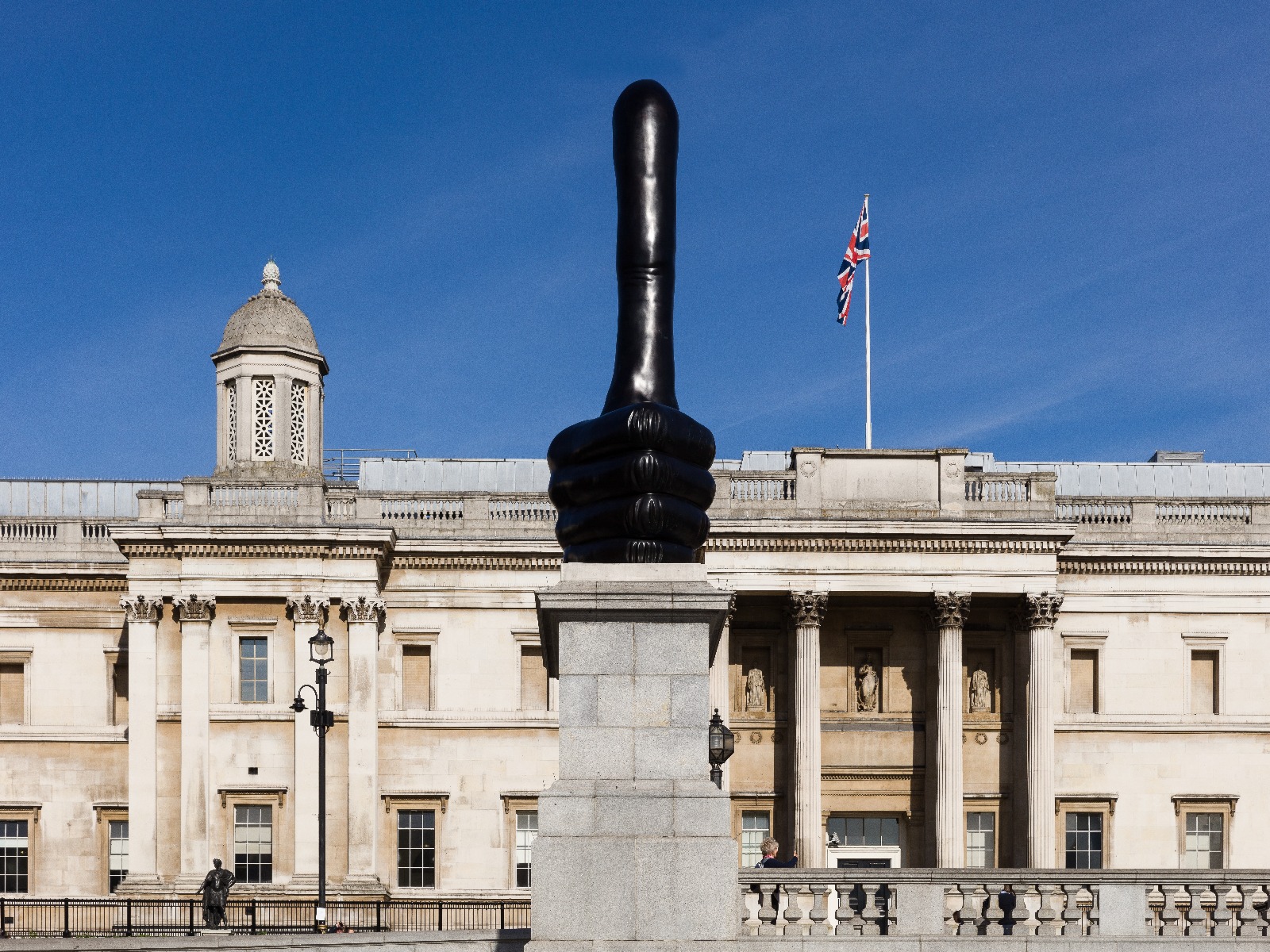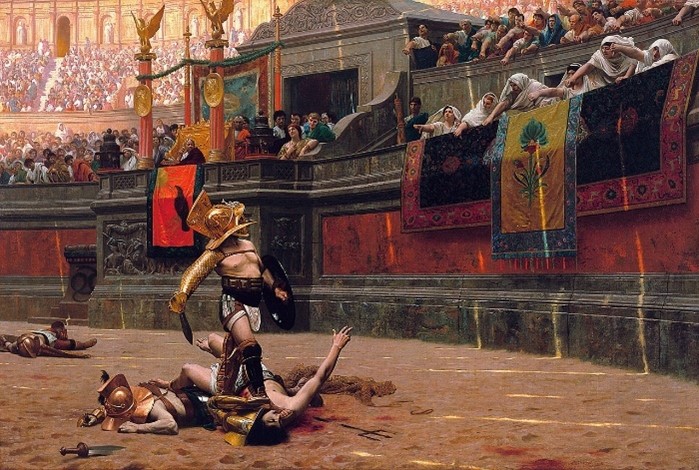

David Shrigley
Maquette for Really Good

Food?
As you might know by now, all the artworks in this museum have something to do with food. On every piece of art something edible is depicted, or it is otherwise connected to food. Why do you think this thumb is in the museum?
Meaning
It could be about fingerfood; sponge fingers, lady fingers, fingerling potatoes, thumbprint cookies, handmade food, chicken fingers, etc.
It could also be about all the pictures of food you scroll through on social media. If you like the picture you can give it a thumbs up. Which is strange, because how do you know if you like the food if you haven’t tasted it?
Maybe it has something to do with all the advertisements for food. Take a walk around any town and everywhere you look are billboards, posters, neon’s, menu’s etc. Every restaurants claims to have the best burger in town, the finest artisanal products, the cheapest snacks, the most varied all-you-can-eat or the most exclusive dishes.
Or it could be about all the ways in which you can give reviews. Via the internet you have the possibility to review almost everything; your cab ride, a book, the view, a song, a movie, a museum, the service, if the information was useful as well as the food or the restaurant. Reviews have become increasingly important for restaurants. Some places even hand out free desserts in exchange for a five star review.
Always right
There isn’t one good answer to why this artwork is in the museum. There are lots of possibilities. That is the power of art, it can mean whatever it means to you. If you feel the artwork is about your grandfather’s freakishly long thumbs, that’s ok (in which case we hope you haven’t inherited them).
Empty pedestal
This isn’t the only sculpture of the tumb the artist has made. This is a special ‘smaller’ version. A bigger one was made for a square in London. That one was almost 7 meters high!

The Fourth Plint
There is a big empty pedestal on the famous Trafalgar Square in London, originally designed to have a statue of King William the Fourth mounted on it. But the statue was never made, so the pedestal remained empty. From 1999 contemporary artist have gotten commissions to create something for the pedestal, now named The Fourth Plint. Every artwork remains for a couple of years and is than replaced by something new. An other artist from the collection of the LAM museum was also asked to create something for the prestigious Fourth Plint. Yinka Shonibare created this ship in 2010.

Nelson's Ship in a Bottle, Yinka Shonibare 2010
Positive
The artist of this work is called David Shrigley. For such a central place in London, he set out to make something positive. He says: ‘I guess this is a work about making the world a better place or it purports to actually make the world a better place. Obviously, this is a ridiculous proposition, but I think it’s a good proposition. Artworks on their own are inanimate objects so they can’t make the world a better place. It is us, so I guess we have to ask ourselves how we can do this.’
Good?
Because the thumb is so bizarrely long, it turns the image into something comical. It really is very positive. Therefore, the image is a bit sarcastic for some people.
Life or death
The gesture of the thumbs up is known by being used in gladiator fights in ancient Rome. With a thumbs up the audience would show that a gladiator was to be spared. A thumbs down, however, meant a gladiator was to be put out of his misery.
Myth
It isn’t entirely clear where the thumbs gesture comes from, but historians agree that it wasn’t used the way we think it was in Rome. It is most likely that the audience showed their thumbs whenever a gladiator was allowed to live. But when the opposite had to take place, the audience buried their thumb into their fists. The myth of the thumbs up or down probably stems from a painting by Jean-Léon Gérôme.

Pollice Verso, Jean-Léon Gérôme 1872
Thumbs up
The first time we know for sure the Thumbs up gesture was used, was in the First World War. When a mechanic checked an airplane they would signal the pilot with a thumb up to show it was ready for take-off. The gesture and the expression ‘Thumbs up’ was officially born.
Almost always right
Almost always a thumbs up means it is going well. But it also has some different meanings. Whenever you are scuba diving, it means you are going up. Letting somebody know you are all right under water is done with the ‘ok’ sign. That is done by pressing the tips of your index finger and thumb together while sticking the other fingers up. A thumb up can also mean you want to catch a ride, it is the international sign for hitchhikers. And lastly, on Sardinia it is wise not to show your thumb. On the Italian island it roughly means the same as showing somebody your middle finger.
Who is David Shrigley
Watch this 30 minutes interview with David to get to know him a little bit.
Select an artwork that you have walked passed without giving it much thought. Look at it closely and do some research into it. Was



